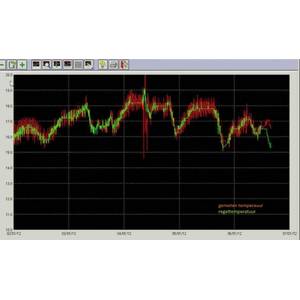Wist u dat de inblaastemperatuur de oorzaak kan zijn van een mindere kwaliteit van uw champignons? Als adviseur merk ik dat telers bij kwaliteitsproblemen zoals schubben, bruine verkleuring en bacterievlekken er toch niet aan denken om de stabiliteit van de inblaastemperatuur te controleren.
De inblaastemperatuur bepaalt in hoge mate het klimaat in de cel. De inblaastemperatuur wordt gemeten op het moment dat de lucht de champignoncel wordt ingeblazen en schommelt normaalgesproken met 1oC tot 1,5oC in 5 minuten. Bij een groter temperatuurverschil schommelt het klimaat in de cel te veel. Bij een grote instabiliteit van de inblaastemperatuur kun je er van uitgaan dat de R.V. in de cel ook veel schommelt. Maar dat zie je niet in de R.V.-meting. Let daar dus goed op!
Als de luchtklep en de ventilator te snel reageren, dan gaat de inblaastemperatuur snel op en neer. Dit gebeurt vooral bij koud en droog weer.
Door onjuiste instellingen kan bijvoorbeeld een verwarmingsklep te snel open of dicht gaan. Vraag uw installateur om deze met u na te kijken. Doe dit vooral niet zelf! Voor u het weet, bent u verder van huis
Een klep die niet helemaal afsluit, een gebrekkige watertoevoer. Allemaal zaken die de inblaastemperatuur beïnvloeden. Door bij problemen de verwarmingspomp of koelpomp te controleren kunt u het probleem verhelpen.
Vergeet de inblaastemperatuur dus niet!
Mark den Ouden
Bron: Champignon Blog – Mark den Ouden
Phase I composting is initiated by mixing and wetting the ingredients as they are stacked in a rectangular pile with tight sides and a loose center. Normally, the bulk ingredients are put through a compost turner. Water is sprayed onto the horse manure or synthetic compost as these materials move through the turner. Nitrogen supplements and gypsum are spread over the top of the bulk ingredients and are thoroughly mixed by the turner. Once the pile is wetted and formed, aerobic fermentation (composting) commences as a result of the growth and reproduction of microorganisms, which occur naturally in the bulk ingredients. Heat, ammonia, and carbon dioxide are released as by-products during this process. Compost activators, other than those mentioned, are not needed, although some organic farming books stress the need for an “activator.”
Mushroom compost develops as the chemical nature of the raw ingredients is converted by the activity of microorganisms, heat, and some heat-releasing chemical reactions. These events result in a food source most suited for the growth of the mushroom to the exclusion of other fungi and bacteria. There must be adequate moisture, oxygen, nitrogen, and carbohydrates present throughout the process, or else the process will stop. This is why water and supplements are added periodically, and the compost pile is aerated as it moves through the turner.
Gypsum is added to minimize the greasiness compost normally tends to have. Gypsum increases the flocculation of certain chemicals in the compost, a

Copyright © 2024 – All rights reserved
Deze website maakt gebruik van cookies om ervoor te zorgen dat u de beste ervaring op onze website krijgt.